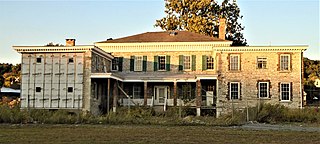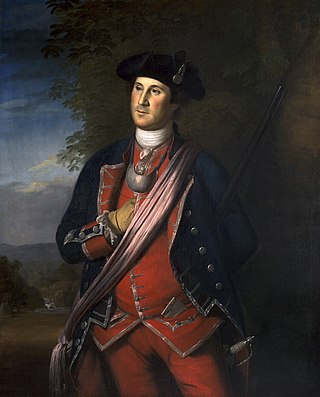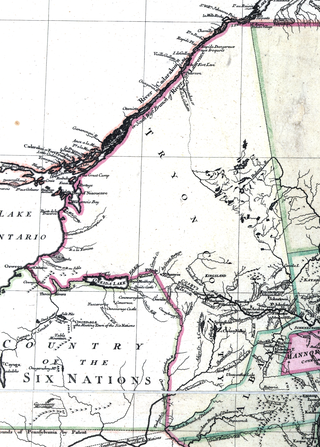
The American Revolutionary War, also known as the Revolutionary War or American War of Independence, was the military conflict of the American Revolution. American Patriot forces largely under George Washington's command defeated the British. In the resulting Treaty of Paris (1783), the British recognized the independence and sovereignty of the United States. American Patriot forces eventually gained the support of the Kingdom of France and the Kingdom of Spain. The British and Loyalist forces also included Hessian soldiers from Germany. The conflict was fought in North America, the Caribbean, and the Atlantic Ocean.

Sir William Johnson, 1st Baronet, was a British Army officer and colonial administrator from Ireland. As a young man, Johnson moved to the Province of New York to manage an estate purchased by his uncle, Royal Navy officer Peter Warren, which was located in territory of the Mohawk, one of the Six Nations of the Iroquois League, or Haudenosaunee. Johnson learned the Mohawk language and Iroquois customs, and was appointed the British agent to the Iroquois. Because of his success, he was appointed in 1756 as British Superintendent of Indian Affairs for all the northern colonies. Throughout his career as a British official among the Iroquois, Johnson combined personal business with official diplomacy, acquiring tens of thousands of acres of Native land and becoming very wealthy.

Thayendanegea or Joseph Brant was a Mohawk military and political leader, based in present-day New York and, later, Brantford, in what is today Ontario, who was closely associated with Great Britain during and after the American Revolution. Perhaps the best known Native American of his generation, he met many of the most significant American and British people of the age, including both United States President George Washington and King George III of Great Britain.

The Invasion of Quebec was the first major military initiative by the newly formed Continental Army during the American Revolutionary War. The objective of the campaign was to seize the Province of Quebec from Great Britain, and persuade French-speaking Canadiens to join the revolution on the side of the Thirteen Colonies. One expedition left Fort Ticonderoga under Richard Montgomery, besieged and captured Fort St. Johns, and very nearly captured British General Guy Carleton when taking Montreal. The other expedition, under Benedict Arnold, left Cambridge, Massachusetts, and traveled with great difficulty through the wilderness of Maine to Quebec City. The two forces joined there, but they were defeated at the Battle of Quebec in December 1775.

John Trumbull was an American artist of the early independence period, notable for his historical paintings of the American Revolutionary War, of which he was a veteran. He has been called the "Painter of the Revolution".

Benjamin West, was a British-American artist who painted famous historical scenes such as The Death of Nelson, The Death of General Wolfe, the Treaty of Paris, and Benjamin Franklin Drawing Electricity from the Sky.

The Mohawk Valley region of the U.S. state of New York is the area surrounding the Mohawk River, sandwiched between the Adirondack Mountains and Catskill Mountains, northwest of the Capital District. As of the 2010 United States Census, the region's counties have a combined population of 622,133 people. In addition to the Mohawk River valley, the region contains portions of other major watersheds such as the Susquehanna River.

John Butler was an American-born military officer, landowner, merchant and colonial official in the British Indian Department. During the American Revolutionary War, he was a prominent Loyalist who led the provincial regiment known as Butler's Rangers on the frontiers of New York and Pennsylvania. Born in Connecticut, he moved to New York with his family, where he learned several Iroquoian languages and worked as an interpreter in the fur trade. He was well-equipped to work with Mohawk and other Iroquois warriors who became allies of the British during the rebellion.

Brigadier-General Sir John Johnson, 2nd Baronet was an American-born military officer, magistrate, landowner in the British Indian Department who fought as a Loyalist during the American Revolutionary War. He was the son of Sir William Johnson, 1st Baronet, who was the first British Superintendent of Indian Affairs. He inherited his father's baronetcy and estate in 1774.

Guy Johnson was an Irish military officer and diplomat. He served on the side of the British during the Revolutionary War, having migrated to the Province of New York as a young man and worked with his uncle, Sir William Johnson who served as the British Superintendent of Indian Affairs of the northern colonies.

The King's Royal Regiment of New York, also known as Johnson's Royal Regiment of New York, King's Royal Regiment, King's Royal Yorkers, and Royal Greens, were one of the first Loyalist regiments, raised on June 19, 1776, in British Canada, during the American Revolutionary War.

The Four Indian Kings or Four Kings of the New World were three Mohawk chiefs from one of the Five Nations of the Iroquois Confederacy and a Mohican of the Algonquian peoples, whose portraits were painted by Jan Verelst in London to commemorate their travel from New York in 1710 to meet the Queen Anne of Great Britain. The three Mohawk were: Sa Ga Yeath Qua Pieth Tow of the Bear Clan, called King of Maquas, with the Christian name Peter Brant ; Ho Nee Yeath Taw No Row of the Wolf Clan, called King of Canajoharie, or John of Canajoharie; and Tee Yee Ho Ga Row, meaning "Double Life", of the Wolf Clan, also called Hendrick Tejonihokarawa or King Hendrick. The Mohican chief was Etow Oh Koam of the Turtle Clan, mistakenly identified in his portrait as Emperor of the Six Nations. The Algonquian-speaking Mohican people were not part of the Iroquois Confederacy. Five chiefs set out on the journey, but one died in mid-Atlantic.
Lt.-Colonel Christopher Carleton (1749–1787) was born into an Ulster military family in Newcastle-upon-Tyne, England. Christopher's parents died at sea when he was only four years old and his uncles, Guy Carleton, the future Governor General of Canada and Commander-in-Chief, North America, along with Thomas Carleton, later the 1st Governor of New Brunswick, saw to his education and upbringing. At the age of twelve, Chistopher joined the British Army as an ensign in the 31st Regiment of Foot. Before his first tour of duty in North America, Chistopher married Anne Howard, whose sister Maria was the wife of Guy Carleton. While in North America, Christopher Carleton met Sir William Johnson and lived among the Mohawk Indians, learning their language and partaking in their customs. He would remark in later life that the time spent living with the Mohawks was the happiest of his life. These skills would serve him well later. Christopher would be back in England when the American Revolutionary War broke out in 1775.

Guy Park, also known as Guy Park State Historic Site or Guy Park Manor, is a house built in 1774 in the Georgian style for Guy Johnson, the Irish-born nephew and son-in-law to Sir William Johnson, 1st Baronet, the British Superintendent for Indian Affairs in colonial New York. Built of limestone, the house was originally situated on a square mile of land on the north side of the Mohawk River and near it for access to water transportation.
The Battle of Ridgefield was a series of American Revolutionary War skirmishes in Danbury, Connecticut and Ridgefield, Connecticut.

The Iroquois, also known as the Five Nations or the Six Nations and by the endonym Haudenosaunee, are an Iroquoian-speaking confederacy of Native Americans and First Nations peoples in northeast North America and Upstate New York. They were known during the colonial years to the French as the "Iroquois League", and later as the "Iroquois Confederacy". The English called them the "Five Nations", including the Mohawk, Oneida, Onondaga, Cayuga, and Seneca. After 1722, the Iroquoian-speaking Tuscarora from the southeast were accepted into the confederacy, which became known as the Six Nations.

Colonial American military history is the military record of the Thirteen Colonies from their founding to the American Revolution in 1775.

Tryon County was a county in the colonial Province of New York in the British American colonies. It was created from Albany County on March 24, 1772, and was named for William Tryon, the last provincial governor of New York. The county's boundaries extended much further than any current county. Its eastern boundary with the also-new Charlotte County ran "from the Mohawk River to the Canada line, at a point near the old village of St. Regis and passing south to the Mohawk between Schenectady and Albany." It extended north to the St. Lawrence River; its western boundary was the Treaty of Fort Stanwix's Line of Property, following the Unadilla River, Oneida Lake, Onondaga River and Oswego River to Lake Ontario, as the Iroquois Confederacy still controlled locations further west in the Indian Reserve. Tryon County's seat was Johnstown, which is today the county seat of Fulton County. The Tryon County Courthouse, built in 1772–1773, was listed on the National Register of Historic Places in 1972. The Tryon County Jail, also built in 1772–1773, was listed on the National Register of Historic Places in 1981.

General Johnson Saving a Wounded French Officer from the Tomahawk of a North American Indian is a painting by the British-American artist Benjamin West, completed between 1764 and 1768. It depicts a scene during the French and Indian War, and was painted a few years after the event depicted in the painting, and is now in the collection of Derby Museum and Art Gallery.

















